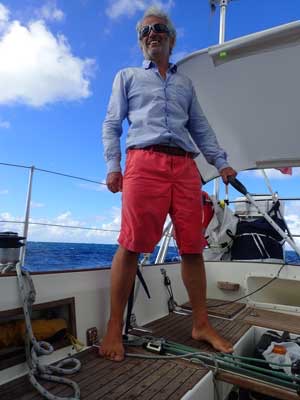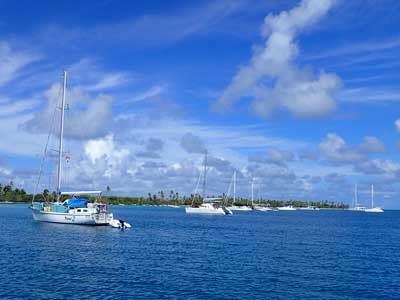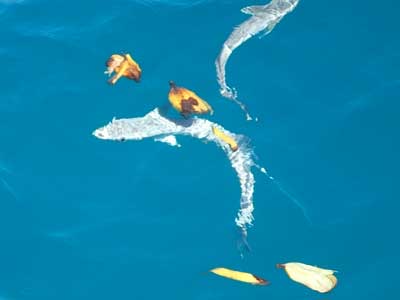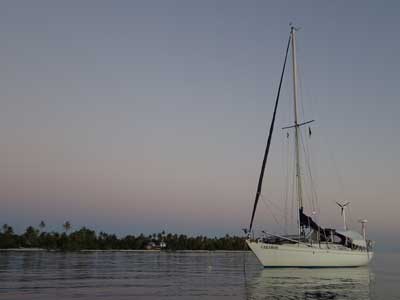The bottle top beach

16:13.52S 145:33.4W It was time to head north across the lagoon to Rotoava, the main, and only other village, on Fakarava. Our scuba diving course was due to start in two days’ time.
As we, oh so carefully, headed up the narrow ‘marked’ channel (the markers were several miles apart), we were amazed to see the French boat that had got stuck on a reef the day before when it cut the corner, heading, parallel to us, through uncharted waters. Even though our electronic chart was accurate, one of us was permanently on lookout for coral reefs.
Franco steering and keeping a lookout The breeze carried us along nicely on the flat water of the lagoon and we soon arrived off Pakacota Yacht Services, about two thirds of the way to the village. We had decided to stop here for a couple of nights. This was our first time anchoring in coral and we experimented with the ‘buoy method’. We attached discarded pearl farm buoys we had collected on our paddling trip to the motu, to the anchor chain at five metre intervals starting at one and a half times the depth. By raising the anchor chain off the bottom, there is less risk of it wrapping around coral heads. It seemed to work. The b(u)oys were Al, Bob, Chas, Dave and Ed.
Pakacota anchorage When we snorkelled to check that all was fine, we were amused to find three remora fish stuck to Caramor, they had jumped shark. These fish have a suction pad on the top of their heads with which they stick to sharks and other animals. I was fairly sure I knew which shark they had come from as I have a photo of a small shark with three large remoras. Their prospects, attached to Caramor, were not good, as we don’t eat fish. Every time we threw something overboard, like a banana skin, they came to investigate. We nicknamed them Rémy, René and Rose-Marie.
Rémy and Rose-Marie disappointed by the banana skins A short distance form Caramor, a manta ray looped the loop and we watched enthralled. This is one of the ways they feed and we have been told the motion creates something akin to a whirlpool of plankton. Matthieu and his wife own Pakacota Yacht Services and we had heard good things said about them. We didn’t need any yacht services so we decided to go in for a drink. All the Anglo-Saxon yachties were huddled around the wifi whereas the three French guys were chatting with Matthieu. We joined them. Matthieu thought a ‘Swiss-Jersey’ partnership was hilarious. “Who lends money to who?” He asked. He has to be the palest Polynesian ever, his mother is Scottish and his father French. We spent a sociable afternoon then as the sun started to set, we took Matthieu’s dog for a walk though she soon got bored and headed back without us. At Pakacota, the land separating the lagoon from the ocean is a mere 400m wide. We walked along the beach on the Pacific side. It is exposed to the east, the predominant wind direction and was covered in plastic rubbish, mostly bottle tops. Every step we took, I counted 5 tops at least. So far in French Polynesia we have seen very little rubbish and I was really shocked. All of this rubbish has come from elsewhere, swept along by the trade winds. Every so often there was a large pile of plastic rubbish, a sign that there has been attempts to gather it all up.
Caramor at Pakacota |



